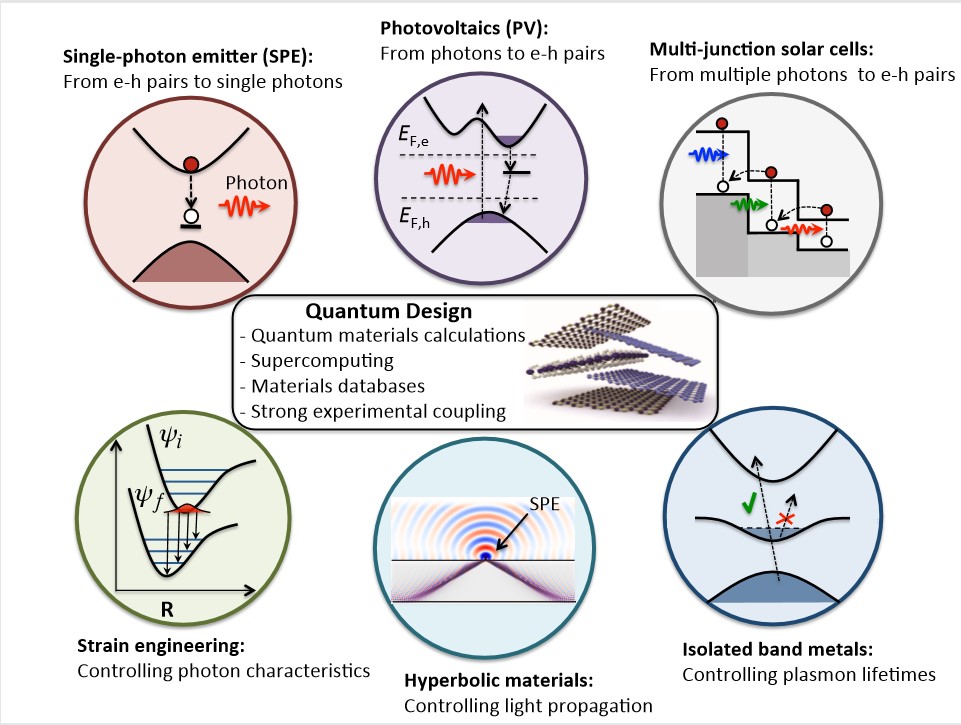ERC-LIMA

Summary:
The overarching idea of LIMA is to use advanced quantum mechanical computer simulations to perform rational design of new materials with tailored optical properties that can be used for high-efficiency solar cells and single- photon quantum technologies, respectively. In terms of materials, the focus is primarily, but not exclusively, on atomically thin two-dimensional (2D) materials, which represent an emergent class of materials with quite distinct properties as compared to conventional bulky materials. One important specific aim is the identification of novel layered structures composed of 2D materials stacked in a carefully designed sequence with potential to reach solar-to-electricity power conversion efficiencies in excess of 50%. Another specific goal is to find stable point defects in wide band gap insulators that can be used to realize “on demand” single photon light sources - a fundamental prerequisite for several emergent quantum technologies including quantum communication. To reach these goals, the project will develop computational methods for quantifying the non-radiative losses that limit light-matter interactions, and thereby enable a realistic assessment of the actual performance of a given material. With its rational approach to materials design, LIMA will help to accelerate the development of new and improved optical materials to the benefit of our economy and society.
Selected results so far (Oct. 2019):
An important milestone was the launching of the Computational 2D Materials Database (C2DB) – a fully open and searchable online database containing structures and a variety of electronic, optical and magnetic properties for more than 4000 2D materials (https://cmr.fysik.dtu.dk/c2db/c2db.html). The C2DB has subsequently formed the basis for high-throughput screening studies where a number of novel 2D ferromagnetic semiconductors and topological insulators have been identified. A new type of 2D materials with broken mirror symmetries – the so-called Janus monolayers – have been investigated, and their potential as building blocks for advanced opto-electronic devices has been demonstrated and disseminated in several papers. In collaboration with Frank Koppens at ICFO, Barcelona, we have studied intersubband transitions in van der Waals quantum wells consisting of a few-layer stacks of 2D semiconductors, as a novel platform for light-matter interactions.
LIMA-related publications:
High throughput computational screening for 2D ferromagnetic materials: the critical role of anisotropy and local correlations
D. Torelli, K. S. Thygesen, and T. Olsen,
2D Materials 6, 045018 (2019)
Enhancing and Controlling Plasmons in Janus MoSSe-Graphene Based van der Waals Heterostructures
L. S. R. Cavalcante, M. N. Gjerding, and K. S. Thygesen,
J. Phys. Chem. C 123, 16373 (2019)
Discovering two-dimensional topological insulators from high-throughput computations
T. Olsen, T. Okugawa, D. Torelli, T. Deilmann, and K. S. Thygesen,
Phys. Rev. Materials 3, 024005 (2019)
Efficient Charge Separation in 2D Janus van der Waals Structures with Built-in Electric Fields and Intrinsic p-n Doping
A. C. Riis-Jensen, M. Pandey, and K. S. Thygesen,
J. Phys. Chem. C 122, 24520 (2018)
Stacked Janus Device Concepts: Abrupt pn-Junctions and Cross-Plane Channels
M. Palsgaard, T. Gunst, T. Markussen, K. S. Thygesen, and M. Brandbyge,
Nano Letters 18, 7275 (2018)
Nano-imaging of intersubband transitions in van der Waals quantum wells
P. Schmidt et al.
Nature Nanotechnology 13, 1035 (2018)
Unraveling the not-so-large trion binding energy in monolayer black phosphorus
T. Deilmann and K. S. Thygesen,
2D Materials 5, 041007 (2018)
The Computational 2D Materials Database: high-throughput modeling and discovery of atomically thin crystals
S. Haastrup et al
2D Materials 5, 042002 (2018)
Interlayer Excitons with Large Optical Amplitudes in Layered van der Waals Materials
T. Deilmann and K. S. Thygesen
Nano Letters 18, 2984 (2018)
Dissociation of two-dimensional excitons in monolayer WSe2
M. Massicotte et al., Nature Communications 9, 1633 (2018
“LIMA is funded by the European Research Council (ERC) under the European Union’s Horizon 2020 research and innovation program (Grant Agreement No. 773122)."

Contact
Kristian Sommer Thygesen Professor, Section leader Phone: +45 45253188 Mobile: +45 93511668 thygesen@fysik.dtu.dk